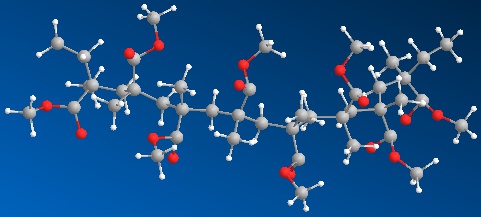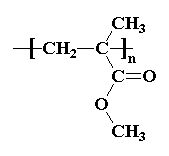

Poly(methyl methacrylate), which lazy scientists call PMMA, is a clear plastic, used as a shatterproof replacement for glass. The clear barrier at the ice rink which keeps hockey pucks from flying in the faces of hockey fans is made of PMMA. The chemical company Rohm and Haas makes windows out of it and calls it Plexiglas®. Ineos Acrylics also makes it and calls it Lucite. Lucite is used to make the surfaces of hot tubs, sinks, one-piece bathtub/shower units, among other things.
When it comes to making windows, PMMA has another advantage over glass. PMMA is more transparent than glass. When glass windows are made too thick, they become difficult to see through. But PMMA windows can be made as much as 13 inches (33 cm) thick, and they're still perfectly transparent. This makes PMMA a wonderful material for making large aquariums, with windows which must be thick in order to contain the high pressure of millions of gallons of water. In fact, the largest single window in the world, an observation window at California's Monterrey Bay Aquarium, is made of one big piece of PMMA which is 54 feet long, 18 feet high, and 13 inches thick (16.6 m long, 5.5 m high, and 33 cm thick).
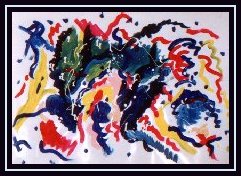
PMMA is also found in paint. The painting on your right, Acrylic Elf, was painted by Pete Halverson with acrylic paints. Acrylic "latex" paints often contain PMMA suspended in water.
But PMMA is more than just plastic and paint. Often lubricating oils and hydraulic fluids tend to get really thick and even gummy when they get really cold. This is a real pain when you're trying to operate heavy construction equipment in really cold weather. But when a little bit PMMA is dissolved in these fluids it keeps them from getting thick in the cold, and machines can be operated down to -100 oC (-150 oF), that is, presuming the rest of the machine can take that kind of cold!
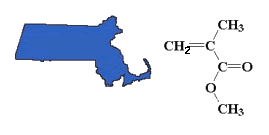 As you can see from the picture, the structure of methyl methacrylate kind of looks like Massachusetts. But Massachusetts doesn't polymerize, because there's only one. Here's a better, 3-D look at the monomer methyl methacrylate:
As you can see from the picture, the structure of methyl methacrylate kind of looks like Massachusetts. But Massachusetts doesn't polymerize, because there's only one. Here's a better, 3-D look at the monomer methyl methacrylate:
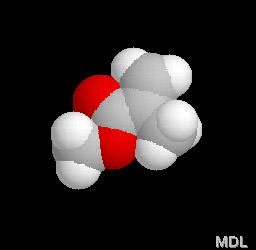
|
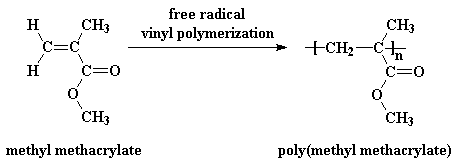
|
The two images below show the 3D structures of two different kinds of PMMA. The one on the left is what you get with free radical polymerization. It is called "atactic," meaning there is no special stereochemistry between pendent groups. Lots of free radical polymers are atactic, and because of that, they are not crystalline and behave like glassy materials for the most part. The structure on the right is for a "syndiotactic" PMMA. This polymer has a very regular sequence of pendent groups. That makes it easier to pack into crystals, and that gives it very different properties than the atactic version.
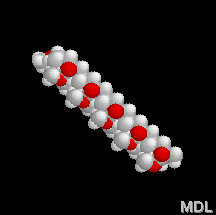
|
And if that's not weird enough for you, here's a THIRD version of PMMA called "isotatctic." In this isomer, all the groups of one kind are lined up on one side of a planar zig-zag of backbone carbons. And that means all the groups of the other kind are on the opposite side. Contrast that to the syndiotactic version in which the two groups alternate on that imaginary planar zig-zag.
Nature doesn't like that arrangement very much, so the chain twists to relieve the "steric strain" also called "steric interaction." Simply put, the relatively big carboxy methyl groups bang into each other so the chain twists in a way to stop that. And the best way to do that "twist" (remember the dance?) is to form a helical conformation. If you look closely at the pop up 3D version (click on the image below), zoom in and out, rotate it around and about, you'll see the beautiful helix formed. Not bad, Mother Nature. We love you and all your twists and turns.
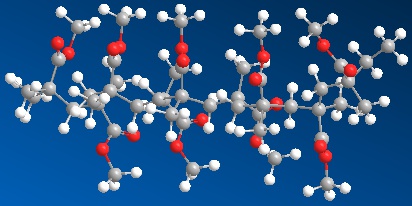
PMMA is a member of a family of polymers which chemists call acrylates, but the rest of the world calls acrylics. And just to round out this information packed page, we should tell you there's another polymer used as an unbreakable glass substitute called polycarbonate. But PMMA is cheaper!
Other polymers used as plastics include: Polyethylene Polypropylene Polyesters Polycarbonate Polystyrene PVC Nylon

|
Return to Kinds of Polymers |

|
Return to Main Page |

